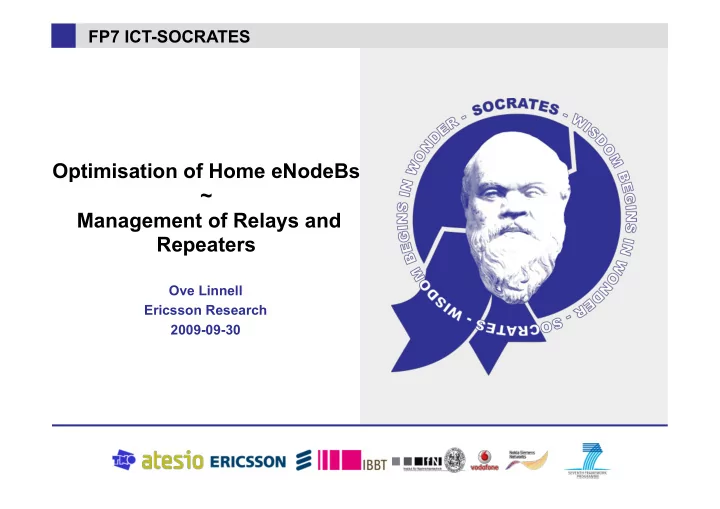

FP7 ICT-SOCRATES Optimisation of Home eNodeBs ~ Management of Relays and Repeaters Ove Linnell Ericsson Research 2009-09-30
Optimisation of Home eNodeBs – Introduction Extensive use of indoor solutions, e.g. HeNBs, foreseen Up to 70% of the traffic load is indoor Used to improve or create coverage and/or capacity in small areas Support open and closed subscriber groups Minimal human intervention Self-optimisation needed Two use cases are studied: – Home eNodeB Handover Optimisation – Decide if handover should take place – Optimise handover parameters – Home eNodeB Interference and Coverage Optimisation – Optimise the coverage area while minimising interference WWW.FP7-SOCRATES.EU
Optimisation of Home eNodeBs – Control Parameters and Operator Policy Prioritized Control parameters For interference and coverage optimization For handover optimization – Maximum HeNB power – Hysteresis – Reference signal power – Cell Offset – Maximum UE power – D esired received power in HeNB (P 0 ) Operators may have different marketing priorities and performance targets that should be reflected in the self-optimisation. Attributes proposed for prioritisation: Accessibility (e.g. call setup success ratio) Retainability (e.g. call dropping ratio) Quality (e.g. user throughput) Coverage Other possible requirements – Limit on change in macro performance – Ability to over-ride the self-optimisation Utility function proposed WWW.FP7-SOCRATES.EU
Optimisation of Home eNodeBs – Assessment Criteria Need for metrics and methods to assess the gain of self-optimisation HeNB objectives: High throughput for data Satisfactory speech quality for voice Avoid blocked/dropped calls Minimise negative impact of HeNB on macro network Overall metric based on comparison between HeNB with self-organisation and a reference case Weighted sum of Weighted sum of Overall metric for Capacity metric various blocking and assessment of various QoS metrics Coverage metric dropping metrics algorithm X (Alg_X) Reference value for Reference value for coverage capacity WWW.FP7-SOCRATES.EU
Optimisation of Home eNodeBs – Simulations Prioritized scenarios For handover optimization For interference and coverage optimization – Closed Access HeNBs – Open/Closed Access HeNBs – Varying eNB-HeNB distance – Varying UE speed – Varying HeNB signal strength relative – Hexagonal scenario, one area with to eNB strength houses and HeNBs – Varying load – Varying service type – Simplified test scenario: HeNB UE mobility WWW.FP7-SOCRATES.EU
Optimisation of Home eNodeBs – HO Simulations Best server is determined based purely on received signal strength Illustration of coverage of HeNBs (one color per HeNB) Using 3GPP HO model Macro Back to macro Femto Another femto Pilot SINR (dB) Serving cell Femto Macro Back to macro WWW.FP7-SOCRATES.EU
Optimisation of Home eNodeBs – ICO Simulations 7 sites with 21 cells, one area with a grid of houses and HeNBs HeNB placement varies within the house Requested DL bitrate 1 Mbps Maximum Gain Impact of varying HeNB DL power, DL Throughput P max = 200 mW P max = 80 mW Mbps WWW.FP7-SOCRATES.EU
Management of Relays and Repeaters – Introduction I (II) Relays and repeaters are used to increase coverage and/or capacity of a eNodeB Repeaters receive and amplify the received signal, including received interference. Relays receive the actual data and then retransmit it WWW.FP7-SOCRATES.EU
Management of Relays and Repeaters – Introduction II (II) A new relay/repeater needs to be connected to the network and to be configured In some situations, the relay/repeater may disturb the network without improving coverage/capacity The following areas have been identified as suitable for self-organisation; – Selecting locations for Relays and Repeaters – Automatic generation of configuration parameters – Interference coordination – Self-healing aspects – Load balancing aspects – Handover aspects For now, the MRR work in SOCRATES has been put on hold due to lack of resources and status in standardization WWW.FP7-SOCRATES.EU
Management of Relays and Repeaters – Background and Objectives I Intelligently Selecting Locations for Relays and Repeaters – Avoid time-consuming and costly measurements and/or usage of prediction tools – Automatically identify areas with no coverage or low performance – Generate proposals of repeater and relay positions in order to improve coverage and/or performance Automatic Generation of Configuration Parameters – For repeaters a strong deviation of parameters from mother eNodeB applies – For relays some parameters are to be set up by default values, others are to be deviated from settings of mother eNodeB Interference coordination – The introduction of relays and repeaters introduces new interference scenarios, which are significantly different to conventional macro cell networks. – Manage interference so that both macro and relaying links provide satisfactory throughput and latency Self-healing – Detection of outages of relays / repeaters – Compensation of outages using relays / repeaters WWW.FP7-SOCRATES.EU
Management of Relays and Repeaters – Background and Objectives II Resource Sharing – Relays and Repeaters provide connection for UEs with at least two hops on radio interface, resources can be shared in time and frequency domain – Optimisation of resources used in links to/from repeater with regards to – Throughput – Interference Load balancing aspects – Additional load on backhaul link (eNB – RN) should be considered in load balancing problems – Load balancing between eNB direct user links and backhaul links of the RNs Handover aspects – With Relays and Repeaters, handover settings should be adjusted for handover between – Macro to macro – Macro to relay – Relay to macro – Relay to relay WWW.FP7-SOCRATES.EU
Recommend
More recommend